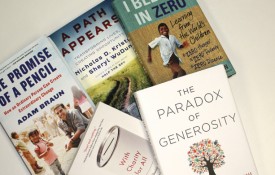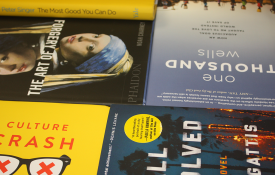
The digital age has brought an accelerated rate of innovation, with new ideas and products changing the world at an incredibly fast rate. Cracking open an actual book – hardboundor paperback – still affords the opportunity to slow down while keeping pace.
The Innovators: How a Group of Hackers, Geniuses, and Geeks Created the Digital Revolution
Walter Isaacson
Simon & Schuster; 2014
560 pp.
THE PLOT Mapping the growth of the computer from the mid-19th century to today, best-selling biographer of Albert Einstein and Steve Jobs offers vivid accounts flavored by insightful analysis of the progress that defined each successive era of innovation.
THE MEAT More than black-and-white technology of programming, transistors, and microchips, Isaacson explores the social and cultural forces that provided the atmosphere for innovation as well as exploring the area where art and science intersected.
THE TWIST Rebuking the idea of solo inventors, the writer never fails to explore the collaborative effort that resulted in many profound innovations and why working as a team served to continuously drive creativity.
Smarter Than You Think: How Technology is Changing Our Minds for the Better
Clive Thompson
Penguin Books; 2014
352 pp.
THE PLOT Technology is not the enemy. “It’s not man vs. machine; it’s man using machine.”
THE MEAT When the nimble yet brute force of the computer mind is combined with “human smarts,” the results are limitless. The printed word predated books, electricity preceded lights, and the Internet age antecedes a largely unimagined world.
THE TWIST In 1997, after being defeated by a computer, world chess champion Garry Kasparov soon realized the key to computer use is not competition but rather collaboration.
How We Got to Now: Six Innovations That Made the Modern World
Steven Johnson
Riverhead Hardcover; 2014
304 pp.
THE PLOT The power of great ideas comes to the fore in this book which highlights six different innovations and their historical consequences. In short, it’s the “hummingbird effect,” how the flap of a butterfly’s wing in California could end up triggering a hurricane in the mid-Atlantic (or more apropos, how a discovery in one field can greatly affect many others).
THE MEAT Gutenberg’s press created the market for spectacles, which led to the microscope, which led to the discovery of cells, which led to discoveries in health. This book captures the strange chains of influence that trigger changes from one field to another.
THE TWIST From his unique viewpoint on world history, we learn that human advancement arrived not from the mind of one man, but the collaboration of a global audience.
Zero to One: Notes on Startups, or How to Build the Future
Peter Thiel
Crown Business; 2014
224 pp.
THE PLOT Legendary entrepreneur Peter Thiel (PayPal, Palantir) says, “Don’t copy. Invent.” If you’re copying a model, today’s profits will be short-lived.
THE MEAT “Today’s ‘best practices’ lead to dead ends,” says Thiel. The rub is that “vertical progress is harder to imagine because it requires doing something nobody else has done.” In short, don’t imitate the competition, rather, improve on the competition, not with incremental steps but with bold new breakthroughs. As explained, copying an idea is akin to going from n-1; creating an idea is going from zero to one.
THE TWIST New ideas are the lifeblood of any company. With plenty of uncharted frontier ahead, the winners will be those who get there first.
 Bold: How to Go BIG, Create WEALTH and IMPACT the World
Bold: How to Go BIG, Create WEALTH and IMPACT the World
Peter Diamandis and Steven Kotler
Simon & Schuster; 2015
336 pp.
THE PLOT How the exponential growth of technology enabled entrepreneurs to not just become instantly successful, but more successful than ever before.
THE MEAT Drawing on the work(s) of Larry Page, Elon Musk, Richard Branson, and Jeff Bezos, Diamandis and Kotler analyze how their habits can be applied elsewhere.
THE TWIST Diamandis, who’s built 15 companies from the ground up, brings his much sought after advice to the table teaching the reader how to leverage and incentive competition for the greater good.













































